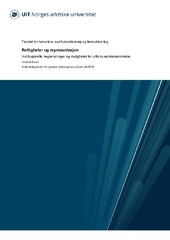| dc.contributor.advisor | Hernes, Hans-Kristian | |
| dc.contributor.author | Falch, Torvald | |
| dc.date.accessioned | 2023-11-13T09:08:07Z | |
| dc.date.available | 2023-11-13T09:08:07Z | |
| dc.date.embargoEndDate | 2028-11-30 | |
| dc.date.issued | 2023-11-30 | |
| dc.description.abstract | Abstract:
The dissertation Rights and representation is a qualitative analysis of constraints and opportunities in developing indigenous political communities and institutions that exercise self-determination. The dissertation is a theoretical-empirical analysis based on the understanding that institutions shape actions, while at the same time there are opportunities for agency within the institutional structural framework that can bring change.
The starting point for the analysis is that indigenous peoples' right to self-determination follows from human rights as a positively created international law, that this right belongs to indigenous peoples as peoples, and that it must be exercised and institutionalized within the nation-states. This sets important structural frameworks for how indigenous self-determination is understood, and what it entails. Therefore, self-determination cannot come anywhere and, in any form, even if the concrete expression will be different in different situations.
The dissertation argues that structural constraints provide an opportunity for indigenous self-determination where this can come in the form of autonomous institutions within the nation-state, where the legitimacy follows from both democratic representation and the rule-of-law. This implies scaled-up and representative institutions which largely have a rule-of-law counterpower function to state domination. In this way, indigenous self-determination institutions will entail a transformation of groups into indigenous political communities, which must essentially be understood as communities of rights that are a supplement to the nation-state’s community of trust. The community of rights ensures recognition of indigenous peoples' identity and difference, and to some extent the traditional basis of life, within the wider nation-state’s community of trust that indigenous peoples both individually and collectively are a part of and depended on. | en_US |
| dc.description.abstract | Čoahkkáigeassu:
Nákkosgirji Rettigheter og representasjon lea kvalitatiiva analysa vejolašvuođain ja ráddjemiin eamiálbmogiid politihkalaš oktavuođaid ja ásahusaid iešmearrideami ektui. Nákkosgirji lea teorehtalaš - empiralaš analysa vuođđuduvvon das ahte ásahusat hábmejit doaibmabijuid, seammás go leat ráddjemat ásahusaid vejolašvuođaide struktuvrralaččat hábmet rievdademiid.
Vuolggasadji eamiálbmogiid vuoigatvuođain iešmearrideapmái, lea ahte dat čuovvut das ahte olmmošvuoigatvuođat lea positiiva gaskariikkalaš láhka, ahte dát vuoigatvuohta gullá eamiálbmogiidda álbmogin, ja ahte galgá doaibmat ja ásahuslaččat gullat nationálastáhtaid siskkobealde. Dát bidjá dehálaš struktuvrralaš ráddjemiid das ahte mo eamiálbmogiid iešmearrideapmi áddejuvvo ja maid dat mielddisbuktá. Iešmearrideapmi ii sáhte dan dihtii boahtit váikko gos ja váikko makkár hámis, váikko geavatlaččat lea guđegelágán guđetge dilálašvuođain.
Nákkosgirji ákkastallá ahte struktuvrralaš ráddjemat addet vejolašvuođa eamiálbmogiid iešmearrideamis gos dat sáhttá boahtit iežaset ásahusain nationálastádaid siskkobealde, gos daid legitimitehta čuovvu sihke demokráhtalaš ovddasteame ja láhkanjuolggadusaid. Dát geažuha ahte gávdnojit stuoribuš ja ovddasteaddji ásahusat, main muhtin muddui lea riektestáhtalaš vuostefámu doaibma stáhta okto mearrideami hárrái. Dán láhkai sáhttet eamiálbmogiid iešmearridanásahusat buktit rievdadusaid joavkkuide eamiálbmotpolitihkalaš oktavuođaide, maid eanaš ferte áddet vuoigatvuođaoktavuohtan, ja lassin nationála luohttámušoktavuhtii. Dát vuoigatvuođaoktavuohta dáhkida dohkkeheami eamiálbmogiid identitehtas ja iešvuođas, ja muhtin muddui árbevirolaš eallinvugiin, siskkobealde dan govda nationálastáhtalaš luohttámušoktavuođas gos eamiálbmogat leat oassin, sihke individuálalaččat ja kollektiivvalaččat ja mii lea dárbbašlaš eaktun sidjiide. | en_US |
| dc.description.abstract | Sammendrag:
Avhandlingen Rettigheter og representasjon er en kvalitativ analyse av hva som er begrensningene og mulighetene for utviklingen av urfolks politiske fellesskap og institusjoner for utøvelse av selvbestemmelse. Avhandlingen er en teoretisk-empirisk analyse grunnet på forståelsen av at institusjoner former handlinger, samtidig som det er handlingsmuligheter innenfor de institusjonelle strukturelle rammene som kan virke til endring.
Utgangspunktet for urfolks selvbestemmelsesrett, er at det følger av menneskerettighetene som en positivt skapt internasjonal rett, at denne retten ligger til urfolk som folk, og at den må utøves og institusjonaliseres innenfor nasjonalstatene. Dette setter viktige strukturelle rammer for hvordan urfolks selvbestemmelse forstås, og hva det innebærer. Selvbestemmelsen kan derfor ikke komme hvor som helst og i hvilken som helst form, selv om det konkrete uttrykket vil være forskjellig i forskjellige situasjoner.
Avhandlingen argumenterer for at strukturelle begrensninger gir et mulighetsrom for urfolks selvbestemmelse hvor dette kan komme i form av egne institusjoner innenfor nasjonalstaten, hvor legitimiteten til disse følger av så vel demokratisk representasjon som rettslige regler. Dette impliserer oppskalerte og representative institusjoner, som i stor grad har en rettsstatlig motmaktsfunksjon til statlig dominering. På dette viset vil urfolks selvbestemmelsesinstitusjoner medføre en omskaping av grupper til urfolkspolitiske fellesskap, som i hovedsak må forstås som rettighetsfellesskap, som er et supplement til det nasjonalstatlige tillitsfellesskapet. Dette rettighetsfellesskapet sikrer anerkjennelse av urfolks identitet og forskjellighet, og i noen grad det tradisjonelle livsgrunnlaget, innenfor det breiere nasjonalstatlige tillitsfelleskapet urfolk både individuelt og kollektivt er en del av, og avhengig av. | en_US |
| dc.description.doctoraltype | ph.d. | en_US |
| dc.description.popularabstract | Popular science summary:
The dissertation Rights and representation is a qualitative analysis of what the opportunity space is for indigenous self-determination.
The dissertation's main question is: What limitations and opportunities are there for developing indigenous political communities and institutions that exercise self-determination?
The theoretical approach to answering this question is that action is shaped by and takes place through institutions. The empirical approach is based on the development of the new Sámi policy in Norway after the crisis created by the conflict over the plans for developing the power plant of the Alta-Kautokeino River from around 1980.
The dissertation consists of four articles, all of which are institutional analyzes of what indigenous self-determination is, and what it entails. The articles go from an overall theoretical reasoning about the conditions for (article 1) and the institutional expression of (article 2) self-determination, to a more concrete assessment of how the Sámi Parliament as a self-determination institution works and is perceived (article 3) and is then developed through self-reinforcing legalization processes (article 4).
Qualitative literature and document studies are used for the analyses. A large part of the empirical evidence is therefore in research literature and public documents. Public documents that are used in the work are part of and an expression of concrete political processes, actions, and decisions that I, as an employee of the Sami Parliament for over 25 years, have a "thick" knowledge of.
The dissertation shows that indigenous people's increasing degree of internationalization, stronger integration into the state, diffuse territorialization and increased urbanization individually and through mutual effects make it most likely that institutions for self-determination will be characterized by democratically elected institutions, where the right to vote rests heavily on individual self-identification and where the policy works to ensure that land rights for groups within the indigenous people can be recognized, and that services and measures have a geographical area of operation. Furthermore, Sámi indigenous nation-building in the form of a community of trust, in the sense of a nation-state, is not possible. The Sámi system-building, on the other hand, involves the development of a supplementary sub-national community of rights which ensures recognition of difference by playing against the state for ever stronger legalization and with the state for securing work, education, and welfare.
The dissertation further shows that Sámi participation in the Sámi electoral system is of an extent that indicates that the Sámi Parliament is perceived as relevant by those who are in the electoral roll. This relevance nevertheless points above and beyond the election dimension in that participation is a way of expressing cultural belonging and recognition of difference. The consequence of this is that reach, in the form of services and measures from the Sámi Parliament, is not necessarily that important for everyone. The Sámi Parliament thus essentially gains importance as a form of non-governmental organization (NGO) within the Norwegian political system. This leads to broad acceptance and recognition of how the cultural difference should be expressed in the form of rights in the nation-state.
In the dissertation, it is also demonstrated that the critical junctures for Sámi politics, such as the development of the Alta power plant and the human rights revolution, led to an early cautious legalization with the recognition of the Sámi in the Constitution and the establishment of the Sámi Parliament following the Sámi Act in 1987-1988. However, this put in to motion self-reinforcing processes between the rule of law and democracy. The legalization ensures against what the state can decide about the Sámi, and the representativeness of the Sámi Parliament ensures a legitimate constitutional customary role as controller of the state by being able to exercise counter-power regulated in various laws. This counterpower makes it difficult for the state to be paternalistic towards the Sámi, which has given ever greater room for self-determination. This is nevertheless a self-determination which has limitations in the opportunities for the Sámi themselves to initiate, prioritize, and govern.
If self-determination for indigenous peoples is to be possible, there must therefore be separate institutions within the nation-state, with legitimacy following from both democratic representation and rule of law. This means scaled-up representative institutions that reach across distances, connect local communities, and pay less attention to locally based traditions. Such scaled-up institutions will have a heavy element of juridical counterpower functions to the state to ensure rights that recognize difference as indigenous people, a difference where the recognition of land and resource rights is crucial.
Self-determination cannot therefore come anywhere and in any form. The dissertation is therefore important for how indigenous self-determination is understood and how efforts are made to achieve it. | en_US |
| dc.description.sponsorship | Sametinget og Norges Forskningsråd (50/50) | en_US |
| dc.identifier.uri | https://hdl.handle.net/10037/31728 | |
| dc.language.iso | nob | en_US |
| dc.publisher | UiT Norges arktiske universitet | en_US |
| dc.publisher | UiT The Arctic University of Norway | en_US |
| dc.relation.haspart | <p>Paper I: Falch, T. & Selle, P. Urfolks selvbestemmelse og demokratiets rolle. Institusjonalisering av rettigheter og representasjon. (Accepted manuscript).
<p>Paper II: Falch, T. & Selle, P. (2022). Et rettighetsfellesskap: samisk systembygging i den norske enhetsstaten. <i>Tidsskrift for samfunnsforskning, 63</i>(1), 44-63. Also available in Munin at <a href=https://hdl.handle.net/10037/24620>https://hdl.handle.net/10037/24620</a>.
<p>Paper III: Falch, T. & Selle, P. (2022). Sametingets relevans og rekkevidde. <i> Norsk statsvitenskapelig tidsskrift, 38</i>(2), 43-59. Also available in Munin at <a href=https://hdl.handle.net/10037/27387>https://hdl.handle.net/10037/27387</a>.
<p>Paper IV: Falch, T. (2022). Samisk selvbestemmelse som motmakt – en statsvitenskapelig analyse av rettsliggjøringen av forholdet mellom samene og staten. <i>Lov og Rett, 61</i>, 547–565. Published version not available in Munin due to publisher’s restrictions. Published version available at <a href=https://doi.org/10.18261/lor.61.9.3>https://doi.org/10.18261/lor.61.9.3</a>. | en_US |
| dc.rights.accessRights | embargoedAccess | en_US |
| dc.rights.holder | Copyright 2023 The Author(s) | |
| dc.rights.uri | https://creativecommons.org/licenses/by-nc-sa/4.0 | en_US |
| dc.rights | Attribution-NonCommercial-ShareAlike 4.0 International (CC BY-NC-SA 4.0) | en_US |
| dc.subject | Samfunnnsvitenskap: 200 | en_US |
| dc.title | Rettigheter og representasjon. Institusjonelle begrensninger og muligheter for urfolks selvbestemmelse | en_US |
| dc.type | Doctoral thesis | en_US |
| dc.type | Doktorgradsavhandling | en_US |


 English
English norsk
norsk

